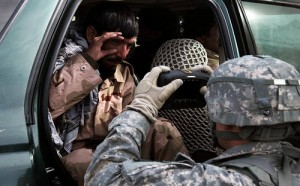Rehman: Drones in Pakistan “Radicalize Footsoldiers, Tribes and Entire Villages”
I had missed Christiane Amanpour’s Monday evening interview with Pakistan’s Ambassador Sherry Rehman, but an article in today’s Express Tribune alerted me to it. Video from the interview is embedded above. Putting aside the ridiculous crap added by CNN producers (I’m assuming Amanpour has better journalistic sense than to clutter news with this crap) alluding to “the marriage from hell” and the god-awful Elton John reference, the key revelation in the interview is that Rehman maintains that even though the US apologized and Pakistan reopened supply routes, that does not mean that Pakistan has agreed to more drone strikes. Further, Rehman emphasized how the strikes produce more insurgents.
From the Express Tribune article:
In an exclusive interview with CNN’s Christiane Amanpour, Ambassador Rehman said America’s drone war “radicalises foot soldiers, tribes and entire villages in our region. And what we see, really, is that increasingly Pakistan is feared as a predatory footprint.”
In response to a question, she denied the assertions that apology over the Salala incident meant that Pakistan had allowed the drone programme to continue. However, she said that the apology over the incident that killed 24 Pakistani soldiers has “opened the space for an opportunity where we can have constructive conversations that might be to the satisfaction of both sides. Right now, we have not given a go-ahead at all”.
But she categorically emphasised that Pakistan’s concerns over the drone strikes could not be ‘brushed aside’.
Ambassador Rehman said that CIA’s covert drone war ‘tests’ the relationship between Pakistan and the US at every juncture. “We honestly feel that there are better ways of eliminating al Qaeda now, which can be done with our help. And we have been doing that consistently. We’re the heavy lifters in this relationship.”
CNN chose not to include in the video this bit of the interview which the Express Tribune found significant:
When questioned about whether Pakistan accepted the accounting of how the Obama administration identified militants, Rehman said it was worrisome “because this leads to what you call signature strikes, if I’m not mistaken, where a certain level of suspected activity generates or motivates the trigger for – I really don’t know what motivates the trigger for X level or Y level of drone strikes.”
I guess CNN doesn’t want us worrying about how the Obama administration might be killing people who don’t deserve it. That would upset the bullshit story they are trying to reinforce. They probably should add a note warning us not to read Glenn Greenwald on this question, either.
At least Rehman understands that when you take the signature strike concept to its extreme and send in follow-on strikes to hit people who are digging through the rubble of the first strike in a search for possible survivors, you are going to radicalize those most closely affected by these actions: the tribes and villages who lose members in these horrific strikes. The CIA’s choice to kill in this manner is clearly assuring the CIA of an even larger group of targets in the future, because for each victim killed in this manner, many new insurgents take up arms.


